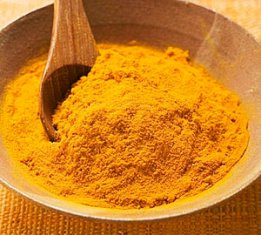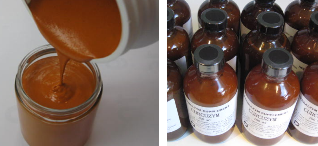 Curcumin, the colouring matter of turmeric (Curcuma longa), has been reported to have chemo preventive as well as anticancer properties against various tumors. Curcumin is a yellow dye used for fabric and food colorations and was used as an antimicrobial finish due to its bactericidal properties on dyed textiles. Curcumin is almost totally insoluble in water and therefore has extremely low bioavailability. However, in the past 10 years there has been an explosion of information, really good documented information, on the affects of curcumin on different biochemical pathways that pertain to cancer and leukemia.
Curcumin, the colouring matter of turmeric (Curcuma longa), has been reported to have chemo preventive as well as anticancer properties against various tumors. Curcumin is a yellow dye used for fabric and food colorations and was used as an antimicrobial finish due to its bactericidal properties on dyed textiles. Curcumin is almost totally insoluble in water and therefore has extremely low bioavailability. However, in the past 10 years there has been an explosion of information, really good documented information, on the affects of curcumin on different biochemical pathways that pertain to cancer and leukemia.
Anticancer Properties of Curcumin
* Curcumin Inhibits Tumorigenesis
* Curcumin Exhibits Antiproliferative Effects against Cancer Cells
* Curcumin Down-Regulates the Activity of Epidermal Growth Factor Receptor (EGFR) and Expression of HER2/neu
* Curcumin Down-Regulates the Activation of Nuclear Factor-kB (NF-kB)
* Curcumin Down-Regulates the Activation of STAT3 Pathway
* Curcumin Activates Peroxisome Proliferator-Activated Receptor-gamma (PPARg)
* Curcumin Down-Regulates the Activation of Activator Protein-1 (AP-1) and C-Jun N-Terminal Kinase (JNK)
* Curcumin Suppresses the Induction of Adhesion Molecules
* Curcumin Down-Regulates Cyclooxygenase-2 (COX-2) Expression
* Curcumin Inhibits Angiogenesis
* Curcumin Suppresses the Expression of MMP9 and Inducible Nitric Oxide Synthase (INOS)
* Curcumin Down-Regulates Cyclin D1 Expression Curcumin Is Chemopreventive
* Curcumin Inhibits Tumor Growth and Metastasis in Animals
* Curcumin Inhibits Androgen Receptors and AR-Related Cofactors
* Curcumin Inhibits Multidrug Resistance (MDR)
Effect of Curcumin on Atherosclerosis and Myocardial Infarction
* Curcumin Inhibits the Proliferation of Vascular Smooth Muscle Cells
* Curcumin Lowers Serum Cholesterol Levels
* Curcumin Inhibits LDL Oxidation
* Curcumin Inhibits Platelet Aggregation
* Curcumin Inhibits Myocardial Infarction
Other Effect of Curcumin
* Curcumin Suppresses Diabetes
* Curcumin Stimulates Muscle Regeneration
Amazingly, curcumin can do all things. Here are a few of curcumin’s “greatest hits”.
As discussed in the previous essay, new study reveals that Notch signaling plays a critical role in regulating breast development and function. This discovery has important implications for breast cancer, since elevated levels of Notch have been linked to breast cancer. The Notch pathway sends signals from a cell’s surface membrane into its nucleus. Those signals activate genes that instruct the cell to make proteins that perform various tasks. Thus, Notch helps to orchestrate the formation of breast tissue: it plays an important role in controlling stem cell number and instructs stem cells to produce luminal cells.
Notch pathway as candidate therapeutic target in Her2/Neu/ErbB2 receptor-negative breast tumors.
Regulation of breast cancer stem cell activity by signaling through the Notch4 receptor.
HER-2, notch, and breast cancer stem cells: targeting an axis of evil.
Study shows that curcumin inhibits cell growth and induces apoptotic processes mediated via Notch signaling pathway. In addition, curcumin and piperine, the main alkaloid from black pepper, separately, and in combination, inhibit breast stem cell self-renewal but do not cause toxicity to differentiated cells.
Targeting breast stem cells with the cancer preventive compounds curcumin and piperine.
One of the fundamental properties of biological membranes is the high lateral integrity provided by the lipid bilayer, the structural core and the foundation of their barrier function. Curcumin was discovered to have membrane-thinning effect and it also weaken the elasticity moduli of 1,2-dioleoyl-sn-glycero-3-phosphocoline (DOPC) bilayer. It is believed that enhanced cytotoxicity of anticancer drugs could result from changes in the biophysical properties and functions of tumor cell membranes.
Membrane-thinning effect of curcumin.
The bound states of amphipathic drugs in lipid bilayers: study of curcumin.
Most important, curcumin inhibits the activation of NF-kB and AKT. NF-kB is a genetic factor that activates the synthesis of pro-inflammatory hormones and anti-cell death survival proteins. AKT is an enzyme that activates other anti-death pathways. It is critical that both these pathways be inhibited. NF-kB regulates the expression of genes involved in many processes that play a key role in the development and progression of cancer. AKT has been linked to the activation of NF-kB. Inhibition of AKT activity decrease NF-κB signaling.
Curcumin Blocks Brain Tumor Formation.
Therapeutic efficacy of curcumin/TRAIL combination regimen for hormone-refractory prostate cancer.
Curcumin inhibits multi-drug resistance normally induced by chemotherapy drugs.
Curcuminoids purified from turmeric powder modulate the function of human multidrug resistance protein 1 (ABCC1).
Modulation of human multidrug-resistance MDR-1 gene by natural curcuminoids.
Curcumin also activates the PPAR-gamma genetic pathway. This pathway inhibits cancer growth in many different ways. The activation of this pathway inhibits the expression of the EGFR (epidermal growth factor receptor).
Therapeutic potential of curcumin in non-alcoholic steatohepatitis.
Peroxisome proliferator-activated receptor gamma in bladder cancer: a promising therapeutic target.
PPARgamma as a therapeutic target for tumor angiogenesis and metastasis.
New pharmacological perspectives and therapeutic potential of PPAR-gamma agonists.
Can PPAR gamma ligands be used in cancer therapy?
Numerous studies have been performed on the biotransformation of curcumin. Study showed that curcumin was first biotransformed to dihydrocurcumin and tetrahydrocurcumin and that these compounds subsequently were converted to monoglucuronide conjugates. Thus, curcumin-glucuronide, dihydro-curcumin-glucuronide, tetrahydrocurcumin-glucuronide, and tetrahydrocurcumin are major metabolites of curcumin in mice.
Recent studies on the biofunctions and biotransformations of curcumin.
 However, keep in mind that curcumin is practically insoluble in water and is not suitable for human consumption. Unfortunately, dietary curcumin in supplement form didn’t help cancers due to extremely low solubility/bioavailability, which means that most of what we swallow goes directly into our gastrointestinal area and is expelled. In order to introduce pure curcumin into the blood via absorption and maximize the activity of curcumin in the body, you have to use CurcuZym. CurcuZym is the only product in the world that has perfect solubility/bioavailability of high purity curcumin enough to induce apoptosis of the cancer stem cells. For many years now, CurcuZym has been used with great success on many terminally ill patients. Otherwise, curcumin wouldn’t have worked.
However, keep in mind that curcumin is practically insoluble in water and is not suitable for human consumption. Unfortunately, dietary curcumin in supplement form didn’t help cancers due to extremely low solubility/bioavailability, which means that most of what we swallow goes directly into our gastrointestinal area and is expelled. In order to introduce pure curcumin into the blood via absorption and maximize the activity of curcumin in the body, you have to use CurcuZym. CurcuZym is the only product in the world that has perfect solubility/bioavailability of high purity curcumin enough to induce apoptosis of the cancer stem cells. For many years now, CurcuZym has been used with great success on many terminally ill patients. Otherwise, curcumin wouldn’t have worked.